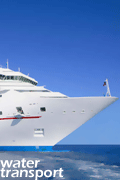|
WASHINGTON, DC - U.S. Secretary of Transportation Ray LaHood joined China's Minister of Transport Li Shenglin today in a historical signing of an agreement to cooperate on the safe transportation of hazardous materials.
Signing the agreement, Secretary LaHood said that both nations' industries - including manufacturing, agriculture, and medical research - need regular access to certain types of dangerous materials to conduct business.
"Chinese businesses ship billions of dollars worth of trade goods around the world each year, including to the United States," said Secretary LaHood. "We are eager to work together to make sure these items are transported safely. And I look forward to participating in this important mission."
Following a joint Transportation Forum held in Beijing last December to address transportation issues including safety, the agreement was shaped to help ensure the safe transport of materials across all modes of transportation - from seaports and aviation to rail and highway.
The U.S.-China Cooperative Project Arrangement on the Safe Transport of Dangerous Goods enables the countries to:
- Develop and strengthen avenues of communication concerning the safe transport of dangerous goods;
- Exchange and cooperate in the development of technical information to support regulatory development;
- Improve harmonization and increase safety by implementing international regulations developed by international forums;
- Cooperate on enforcement and investigative actions to improve dangerous goods transport safety, to include exchange of incident and violation data; and
- Organize training activities to strengthen the capabilities of managerial and technical personnel.
As both nations invest billions of dollars in transportation infrastructure through economic stimulus plans, Secretary LaHood noted that the Dangerous Goods agreement is a step forward on improving transportation's role in fostering a healthy climate for commerce and economic growth, while creating good jobs for both U.S. and Chinese citizens.
The signing took place at the U.S. Department of Transportation. The next Transportation Forum between the two nations will be held at the end of this year in Washington, D.C.
              
posted by transport blogs
@ 10:52 PM
permanent link |
|

Washington, DC—The U.S. Secretary of Transportation today announced allocation of $17 million in federal funding under the American Recovery and Reinvestment Act, 2009 for the Federal Transit Administration's Tribal Transit Program.
"These additional funds will advance the expansion of much needed transit services on our nation's tribal lands," said U.S. Transportation Secretary Ray LaHood. "That means more job creation and greater access to those jobs."
The ARRA tribal transit funds will provide grants to Indian tribes for capital expenditures including transit equipment and facilities. Participants under this program include federally recognized Indian Tribes or Alaska Native villages, groups, or communities as identified by the Bureau of Indian Affairs in the Department of the Interior.
A notice soliciting project proposals to be selected on a competitive basis was published today in the Federal Register. The notice includes application procedures, the criteria that FTA will utilize to select projects, and grant terms, conditions, and reporting requirements.
Tribes will have 60 days to submit project proposals. The Federal Register notice can be found at: http://www.fta.dot.gov/laws/leg_reg_federal_register.html.
Once projects are selected and funding is awarded, tribal recipients must obligate funds by September 30, 2010. Interested parties are encouraged to contact the nearest FTA Regional Office for additional information on the ARRA Tribal Transit Program. A contact list of FTA regional offices may be found at www.fta.dot.gov.
              
posted by transport blogs
@ 9:59 PM
permanent link |
|

posted by transport blogs
@ 9:56 PM
permanent link |
|

When are shipping documents required?
Shipping (transport) documents describe the dangerous goods on the vehicle. Shipping documents are required for the transport of any quantity of dangerous goods if the goods are transported by a transport business and when the Regulations apply.
Shipping documents are not required for the transport of small quantities for private use. "Small quantities" means less than 62.5 litres or 62.5kg of dangerous goods of loads containing Class 2.1, 2.3 and Packing Group I goods, or less than 250 litres or 250kg of other dangerous goods.
What information should be in the shipping document?
The shipping document should detail the consignor's name and telephone number and the description of the dangerous goods including:
- proper shipping name or other recognised name of each dangerous goods*
- dangerous goods class and subsidiary risk (if any)*
- United Nations (UN) Number*
- Packing Group (if any)*
- for packaged goods: the number and type of packages
- for bulk goods: the number and type of each bulk container
- The aggregate quantity of the goods.
- This information is available on the package label and on the Material Safety Data Sheet (MSDS) for the product.
What should I do when I deliver part of the load of dangerous goods?
- The shipping document should be amended to show the approximate quantity of product remaining at any given time during the journey.
- The shipping document for a bulk vehicle which has delivered its load from a compartment or container should show "residues only" (or similar) for these "empty" compartments or containers.
- An information sheet on shipping documents is available from DECC.
Where do I keep shipping documents in the vehicle?
For placard loads, the driver must ensure that the shipping documents are carried in the Emergency Information Holder. The holder should be attached to the driver side door of the cabin and, if this is not practical, the shipping document holder must be in a conspicuous location adjacent to the driver side door in the cabin of the vehicle.
What is emergency information?
Emergency information provides initial information to people at the scene of an incident on "what to do in an emergency situation involving a vehicle transporting a load of dangerous goods".
What is acceptable emergency information?
Acceptable emergency information is either:
- the relevant Emergency Procedures Guides (EPG) for the dangerous goods and the EPG for a vehicle fire; or
- the Dangerous Goods Initial Emergency Response Guide Book (HB76).
- A Material Safety Data Sheet (MSDS) is not acceptable emergency information for transport purposes.
Where do I get emergency information relevant to the dangerous goods on the vehicle?
Standards Australia supplies Emergency Procedure Guides (EPGs) and the Dangerous Goods Initial Emergency Response Guide.
When is emergency information required?
Emergency information is required when transporting a placard load of dangerous goods but may be carried for smaller quantities.
Where do I keep emergency information in the vehicle?
For placard loads, the driver must ensure that the emergency information is carried in the Emergency Information Holder. The holder should be attached to the driver side door of the cabin and, if this is not practical, the emergency information holder must be in a conspicuous location adjacent to the driver side door in the cabin of the vehicle.
When do I need an emergency plan?
When transporting a placard load of dangerous goods, the prime contractor (or rail operator for rail transport) and the consignor must maintain a written emergency plan for dealing with any dangerous situation following an accident or incident.
When do I need to maintain a telephone advisory service?
When transporting a bulk load of dangerous goods by road, the prime contractor or the consignor must maintain a telephone advisory service throughout the journey.
What does a telephone advisory service do?
A telephone advisory service provides advice to the emergency services and dangerous goods authorities. on:
- the construction and properties of the containers in which the dangerous goods are being transported;
- the use of equipment on vehicles on which the dangerous goods are being transported;
- the properties of the dangerous goods;
- methods of safely handling the dangerous goods;
- methods of safely containing and controlling the dangerous goods in a dangerous situation.
              
posted by transport blogs
@ 11:23 PM
permanent link |
|

The U.S. Department of Transportation's Saint Lawrence Seaway Development Corporation (SLSDC) will initiate its planned 10-year program this year to modernize the infrastructure of the U.S. portion of the St. Lawrence Seaway, following President Obama's signing yesterday of the omnibus appropriations bill to fund the federal government for the remainder of fiscal year 2009. The bill includes a total of $31.8 million for the Seaway, which serves the Great Lakes region of North America.
The enacted funding includes more than $17 million allocated to 17 projects under the Seaway's Asset Renewal Program (ARP). A significant amount of the ARP funding in FY 2009 will benefit the regional economy surrounding the two U.S. locks in Massena, N.Y.
"After 50 years of continuous use, the U.S. Seaway infrastructure needs significant capital investment," said U.S. SLSDC Administrator Collister Johnson, Jr. "By enacting this law, President Obama and the U.S. Congress have recognized the vital importance of the St. Lawrence Seaway to the North American economy."
Over the next decade, the ARP will focus on improving aging Seaway infrastructure, conducting maintenance dredging, investing in new technologies, purchasing new equipment, and refurbishing old facilities. This will be the first time in the Seaway's history that a coordinated effort to repair and modernize the U.S. Seaway infrastructure has taken place.
ARP also will complement the asset renewal work already underway on the Canadian portion of the St. Lawrence Seaway System. None of the ARP projects will result in increases to the authorized depth or width of the navigation channel or to the size of the existing U.S. locks.
For more information visit here
http://www.dot.gov/affairs/slsdc0109.htm
              
posted by transport blogs
@ 10:09 PM
permanent link |
|

Freight Transportation Services Index (TSI) Fell 2.3 Percent in January from December
Wednesday, March 11, 2009 - The Freight Transportation Services Index (TSI) fell 2.3 percent in January from its December level, falling for the third consecutive month to its lowest level in more than five years, the U.S. Department of Transportation’s Bureau of Transportation Statistics (BTS) reported today.
The January decline was the fifth monthly decrease in six months. The index has declined 7.7 percent in the last six months, the largest six-month decline since an 8.4 percent decline in 1995. The 5.9 percent decline in the three-month November through January period was the largest three-month decline since April 2000.
The 2.3 percent decline in January was the second January decline in five years and the largest January decline since 1996. The index dropped 0.3 percent in 2007 (Table 3).
At 102.7 in January, the freight TSI is at its lowest level since May 2003 when it was 102.5 and is down 9.2 percent from its historic peak of 113.1 reached in November 2005. For additional historical data, go to http://www.bts.gov/xml/tsi/src/index.xml.
The freight TSI measures the month-to-month changes in the output of services provided by the for-hire freight transportation industries. The index consists of data from for-hire trucking, rail, inland waterways, pipelines and air freight.
The 7.8 percent decline from January to January left the freight index at its lowest January level since 2002.
The 2.3 percent decline in January resulted in a 3.5 percent drop in the freight index in the five years from January 2004, the second five-year decline in the 19-year history of TSI data. The first ever five-year decline was a 2.7 percent decrease from December 2003 to December 2008. The index is still up 2.9 percent in 10 years.
The TSI is a seasonally adjusted index that measures changes from the monthly average of the base year of 2000. It includes historic data from 1990 to the present. Release of the February index is scheduled for April 8.
BTS has issued a technical report explaining the TSI. BTS Technical Report: Transportation Services Index and the Economy is available for download at https://www.bts.gov/pdc/index.xml in the BTS bookstore.
Transportation Services Index for Passengers
The TSI for passengers fell 0.3 percent in January from its December level. The Passenger TSI January 2009 level of 112.6 was 3.8 percent lower than the January 2008 level, the first January-to-January decrease since 2002. The 3.8 percent decline from January to January left the passenger index at its lowest January level since 2006. Despite the recent declines for the year, the passenger index is up 13.5 percent in five years and 20.6 percent in 10 years.
The passenger TSI measures the month-to-month changes in the output of services provided by the for-hire passenger transportation industries. The seasonally adjusted index consists of data from air, local transit and intercity rail.
For more information visit here
http://www.bts.gov/press_releases/2009/bts011_09/html/bts011_09.html
              
posted by transport blogs
@ 5:54 AM
permanent link |
|

posted by transport blogs
@ 10:46 PM
permanent link |
|

Washington, D.C. - President Barack Obama, joined by Vice President Joe Biden and U.S. Transportation Secretary Ray LaHood, today marked the release of $26.6 billion from the American Recovery and Reinvestment Act (ARRA) to states and local transportation authorities to repair and build highways, roads and bridges. The release of the funds came eight days earlier than required by law and took place before more than 500 headquarter employees at the U.S. Department of Transportation.
"This investment in highways will create or save 150,000 jobs by the end of next year, most of them in the private sector," President Obama said. "The jobs that we're creating are good jobs that pay more than average; jobs grinding asphalt and paving roads, filling potholes, making street signs, repairing stop lights, replacing guard rails," he added.
"I've always believed that the toughest moments present the biggest opportunities, and clearly, the President of the United States feels that way, as well," Vice President Biden said. "With this recovery package, we'll be creating jobs, saving jobs, and putting money in people's pockets."
"President Obama is keeping his promise to the American people and he is doing it ahead-of schedule," said Secretary LaHood. "This is a long-overdue investment in our transportation infrastructure and in jobs for Americans."
Secretary LaHood noted that some of the money would be used the same day at a site in Montgomery County, Md., where crews had just started road repairs on a one-mile stretch of Route 650.
State highway departments have already identified more than 100 other transportation projects across the country, totaling more than $750 million, where construction can start within the month. That number is expected to grow substantially as more states submit certifications and begin to receive project approvals.
Each proposed project must be approved by the department's Federal Highway Administration (FHWA). Each state's governor must certify that their proposed projects meet certain conditions and that the state will use ARRA funds in addition to, and not to replace, state funding of transportation projects. The U.S. Department of Transportation will monitor state compliance and track job creation. The projects will be web-posted for the public to see with information on projects accessible at www.recovery.gov.
At the ceremony the President unveiled new logos for government-wide projects completed under the ARRA and the Transportation Investments Generating Economic Recovery (TIGER) logo for transportation projects completed under the ARRA.
Those attending the signing ceremony at the Department of Transportation were members of the team Secretary LaHood created to oversee disbursement of the money and ensure that all transparency and accountability requirements are being met. Known as the Transportation Investment Generating Economic Recovery (TIGER) team, it is composed of officials from across the Department's operating administrations and offices and is co-chaired by Lana Hurdle, deputy assistant secretary for budget and programs, and Joel Szabat, deputy assistant secretary for transportation policy.
President Obama's visit marks the first by a sitting U.S. President with his Vice President to Department of Transportation headquarters. President Obama is the third sitting President to visit the department, following Presidents George W. Bush in 2008, and Ronald Reagan in 1981.
              
posted by transport blogs
@ 9:57 PM
permanent link |
|

There are different kinds of insurance for your vehicle:
- Compulsory Third Party insurance (CTP) is paid with your registration. It is illegal to drive an unregistered vehicle with no CTP coverage. CTP insurance covers vehicle owners and drivers who are legally and financially liable for personal injury to another person in the event of a motor vehicle accident. For further information please visit the Motor Accident Commission website:www.maic.qld.gov.au.
- Third party property damage insurance covers you if you cause damage to other people's property, but does not cover loss of, or repairs to, your own vehicle or property.
- Fire, theft and third party property insurance protects you against damage to other people's property, as well as covering your own vehicle for damage caused by fire or theft.
- Comprehensive insurance gives full cover to your vehicle for property damage, but does not cover injuries to people. Comprehensive insurance protects you against damage to other people's property, as well as covering your vehicle for property damage.
Your vehicle must be safe and registered at all times while using the road. If you make any structural changes to your vehicle, they'll need to be approved by Queensland Transport officers or an agent. Your insurance policy may not cover you if you modify your vehicle without approval and it is involved in a crash.
If you cause a crash with the level of alcohol in your blood or breath over your alcohol limit, the insurer will pay all CTP insurance claims, however the insurer has the right to recover the cost from you.
For more information, contact your insurance company.
              
posted by transport blogs
@ 4:45 AM
permanent link |
|

|
![]()
![]()








